What is Peridot?
Peridot is sometimes referred to as chrysolite. It consists of Olivine and a silicate mineral rich in magnesium, and it measures between 6.5 and 7 on the Mohs scale. The beautiful green color of Peridot comes from the inclusion of iron in its mineral makeup.
The mineral Olivine is the main constituent of Peridot, although Olivine also occurs in igneous rocks such as basalt, dunite, and diabase.
Peridot is not formed in the Earth’s crust but in the molten rock of the Earth’s upper mantle.
The Origin: Where Is Peridot Found?
Peridot can be found in the Canary Islands, USA, Brazil, Egypt, Russia, Sri Lanka, and Ireland.
The History & Lore of Peridot

Peridot has a rich and varied history amongst the peoples of Ancient Egypt.
It is a gem that has long been associated with light, and the Ancient Egyptians referred to it as the Gem of the Sun.
It was said to guard against the terrors of darkness and the night, especially when set in gold.
Peridot is created deep within the Earth, in the upper mantle as opposed to the Earth’s crust.
Most examples of this stone were delivered to the surface by volcanoes, thus enhancing its connection with light and fire.
Early records show that a green gem was mined by the Ancient Egyptians on the island of Topiazios in the Red Sea. This island is now called St John’s or Zabargad.
There is a legend that at the time of mining the island was infested with venomous snakes, making the process of collecting the gems most unpleasant.
The legends state that one of the Pharaohs drove all of the snakes into the sea and thus became one of the most popular rulers of the time!
This green stone has been confused with other gems for different people for centuries.
It became known as one of the varieties of Topaz, because of the location in which it was found.
And there are historians and archeologists who maintain that Cleopatra’s famous collection of Emeralds could well have been Peridots.
The Romans valued Peridot for its ability to keep its green color even when night falls and referred to it as the “Evening Emerald”
They regarded it as a fitting gift for a loved one or betrothed and its light symbolized the flame of love that is never extinguished.
In Hawaii, myth says the Peridot is formed by the tears of the goddess Hele, who governs fire and volcanoes.
Peridot is ascribed to several goddesses in ancient history, including Pax, the Roman goddess of peace, Lakshmi, the Hindu goddess of fortune and abundance.
And Persephone, the Greek goddess of Spring, who represents the rebirth of the Earth every year with new growth and the bursting forth of buds, flowers, and green shoots from the barren earth.
In more modern times, Peridot gained popularity due to the fact that designers decked their Hollywood stars in jewelry of chunky silver and Peridot, Topaz, and other semi-precious stones in the Art Deco style.
How to Identify Peridot

Unfortunately, Peridot fakes are quite common, usually made from green glass. However, authentic Peridot can be identified by using several simple methods.
Visual Clues
Peridot is always green, unlike topaz or fluorite stones which occur in a variety of colors.
The green color is best described as Olive or Forest green, and a real Peridot has hints of yellow, which can be seen with the naked eye.
Take the stone outside into natural daylight and notice if it changes color. A true Peridot will not change color.
Likewise, note any tiny flaws, scratches, or inclusions as these all indicate an authentic specimen.
Refraction of Light
Hold the stone against a light. You should see a double ray inside the gem as Peridot has a double refraction, whereas glass has only one.
Test for Iron
The beautiful green color of Peridot is caused by the inclusion of Iron and magnesium within the stone.
To test for iron at home you should place the Peridot in a basin of water, resting on an inert base such as cardboard or polystyrene.
Pass a magnet over the top of the gemstone. If the magnet attracts the Peridot, even very slightly, you have the genuine article.
Types of Peridot
Peridot is sometimes called Chrysolite or Olivine, but it is all the same gemstone.
There are a few variations in color, but to be called Peridot it must always be green.
In the past, Peridot was sometimes mistaken for emerald, but this is not the case these days.
The most highly valued types of Peridots are those with a deep, grass green color, and the merest tinge of yellow.
Peridot Birthstone Meaning & History
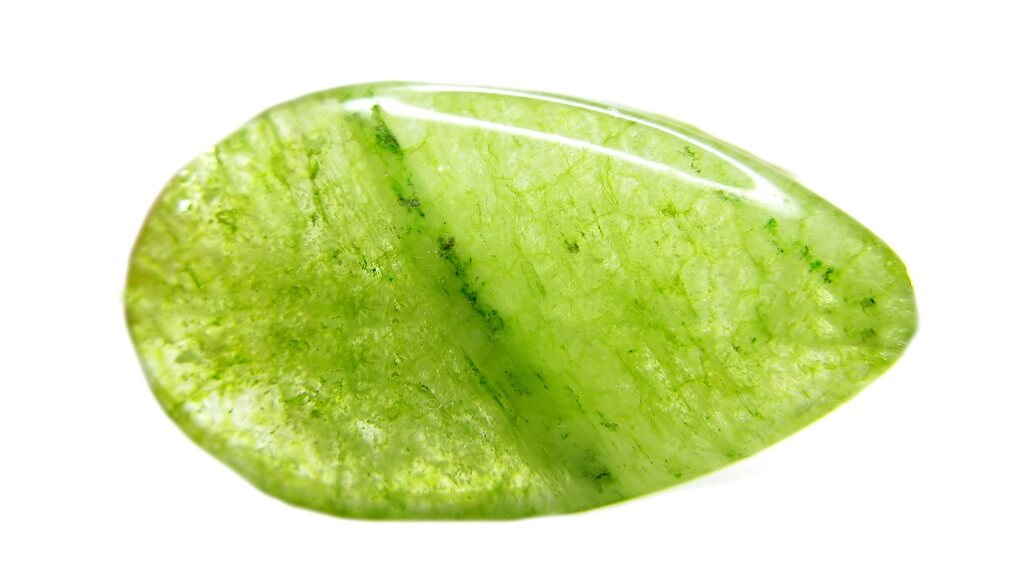
Peridot is the official birthstone for those born in the month of August.
The zodiac signs that take Peridot as one of their birthstones are Virgo (Aug 24-Sept 22) and Libra (Sept 23 to Oct 23)
Virgo
Typical Virgo traits include diligence, attention to detail, perfectionism, and tolerance.
A Virgo will often accord people third and fourth chances and will show understanding and compassion for the weaknesses and foibles of others.
A gift of Peridot to a Virgo can encourage them to show the same level of tolerance and forgiveness towards themselves that they accord to other people.
Virgos are creative and imaginative, as well as being very logical, and analytical thinkers.
Peridot promotes the use of imagination and nurtures the artistic gifts of many Virgos, who tend to reveal their true nature through the mediums of dance, art, and writing.
As for the negative aspects of the Virgo character, their pursuit of perfection can sometimes lead the to make unthinking remarks as to another’s ability or achievements.
Especially if these do not measure up to Virgo’s high standards.
Peridot teaches patience and self-awareness, which may help the over-critical Virgo to think about the impact of their words before they open their mouths!
Libra
Librans are diplomatic and fair-minded, they look for the best in people and situations and are extremely sociable, fun-loving, and optimistic.
Peridot makes an ideal gift for a Libra because they adore beautiful things and appreciate the wonders of the natural world.
Peridot carries the energy and warmth of the Sun, and most Librans are warm, giving, and loving in their interactions with others.
On the negative side, Librans can be so fixated on achieving balance in all things that they become indecisive.
Peridot aids clear thinking and discernment, helping to mitigate the typical Libran trait of overthinking and agonizing over decisions.
Libra is sometimes accused of being vain and this can result in a judgemental attitude towards others, especially their outward appearance.
Libra is often seen as the most self-pitying sign of the zodiac.
Their tendency towards drama and self-absorption makes them feel as though the whole world is against them.
Peridot, with its ability to reveal the truth about ourselves, to ourselves, can help with this trait in a Libra with a “victim mentality”.
Peridot Treatment
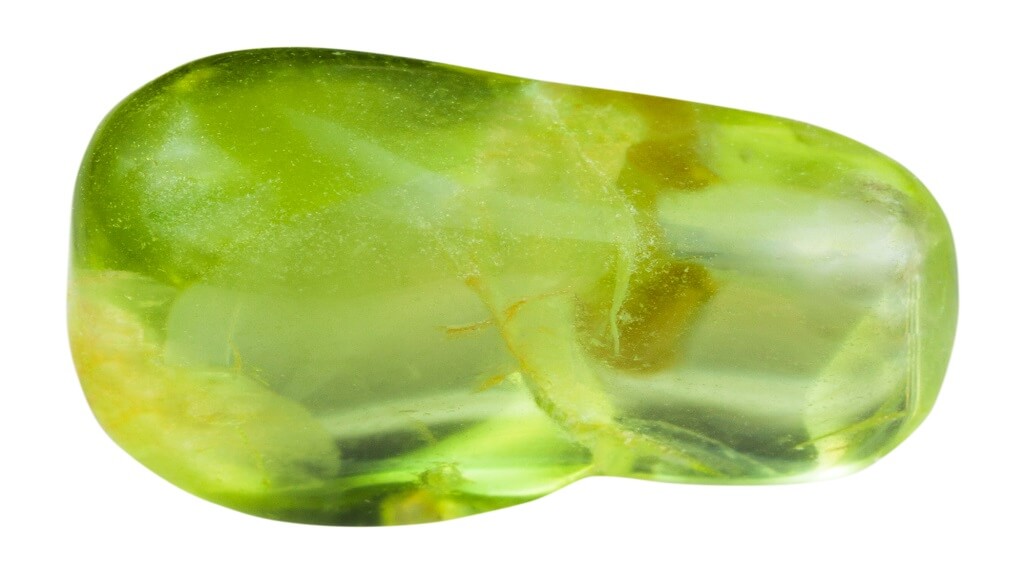
How to Clean and Care for Peridot
Peridot measures between 6.5 and 7 on the Mohs scale and should be protected from hard blows that may chip or fracture the surface of the stone.
The best way to clean it is with warm, soapy water. Peridot is sensitive to hot water so use only cold or lukewarm water to wash it.
To recharge your Peridot and restore its vibration covering it with earth or placing it in a bowl of brown rice for 12 hours is the safest method.
You can charge Peridot in sunlight but avoid leaving it in a hot place for more than one or two hours.
Buyers Guide: Tips & Advice
Genuine Peridot is fairly easy to spot when buying this stone.
Imitations, usually made from green colored glass, tend to look too uniform and perfect in shape, as well as lacking the subtle depths of color of true Peridot.
Peridot Quality Factors
Color
All Peridots are green in color. They are usually described as being “olive” in shade and can be either light or dark olive.
The most valued Peridot color is a pure, rich grass or forest green with a depth of color that shows its best effect in larger gems.
Smaller specimens may reveal hints of yellow. Brownish tints in Peridot stones tend to lower the value.
Clarity
The clarity of Peridot is more obvious in larger gems that are cut to enhance the stone’s reflective qualities.
The term “eye clean” may be used to describe a Peridot that has no inclusions or flaws visible to the naked eye.
Typical inclusions are minuscule dots of other minerals, and the unique, disk-shaped flaws called “lily pads”
Cut
The most important factor in ascertaining the quality of a Peridot stone is the way it is cut.
Peridot can be cut and shaped in many ways, and it is possible to find cabochons, triangles, cushions, ovals rounds, and emerald cuts.
The cut should maximize the depth of color and the light reflective qualities of the gem.
Carat Weight
Peridots are measured in carats, and the larger the carat value the greater the value of the stone.
It is rare to find specimens of Peridot over 10 carats, although there are examples of stones over 50 carats.
The vast majority of stones on the market are about 5 carats in weight.
Peridot and Chakras
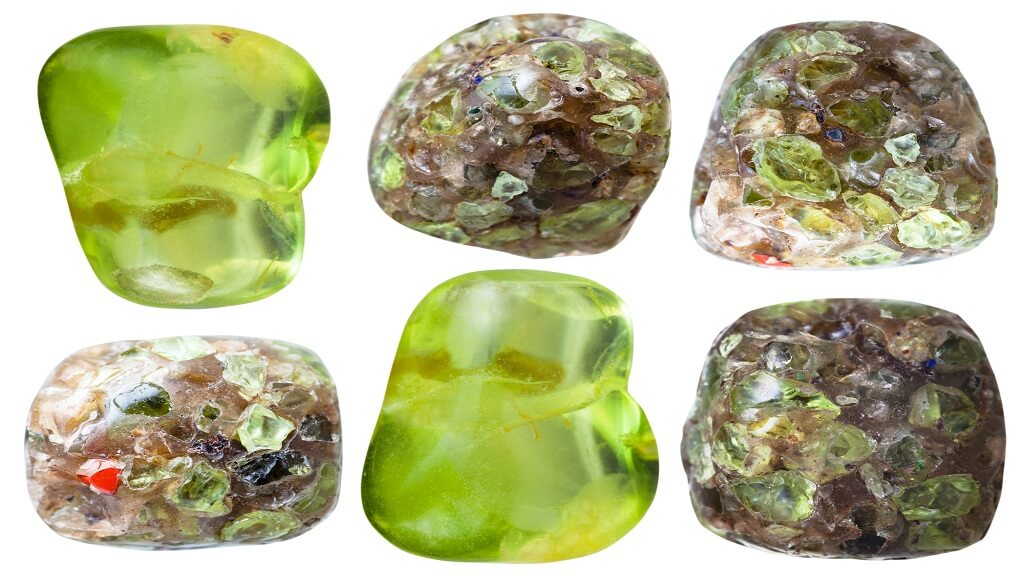
The beautiful green hues of true Peridot work on the green ray of Archangel Raphael to bring healing light and vibrations to the Heart chakra.
Our Heart chakra governs our interactions with the outside world and controls our responses to stimuli or triggers on an emotional level.
It dissolves blockages in the Heart and allows vital, rejuvenating energies to flow freely through the chakra, strengthening and stimulating our capacity for both giving and receiving love.
This blockage keeps us stuck, and the fear increases.
When you feel controlled within a relationship your Heart chakra may begin to close down or freeze.
The same is true if you are the one who does the controlling. Either way, the result is damaging for all concerned.
The gentle energies of Peridot dissolve blocked, or stagnant energies from the Heart chakra and encourage new, more vibrant, and positive vibrations to flow from the Heart to all the chakras.
This enables your chakra system to fully support your emotional and physical bodies.
Peridot also supports the healthy functioning of the Solar Plexus chakra.
This chakra, located at the center of the torso, below the ribcage, and above the navel, is the midpoint of the seven main chakras.
And acts as a two-way channel for the energies flowing up and down the center of your body.
The Solar Plexus is especially prone to blockages and tension, as it has a lot of work to do to keep all the chakra tuned and balanced.
If you experience tightening in your gut when you are nervous or fearful, this is your Solar Plexus reacting to perceived threats from the external world.
Using Peridot to soothe the tension and open the Solar Plexus can bring immediate relief from stress-related abdominal issues.
When your Solar Plexus is open and balanced, you have the vitality and strength to fight physical infections and to digest and assimilate the nutrients you need from your food, water, and from light.
Peridot Healing Properties
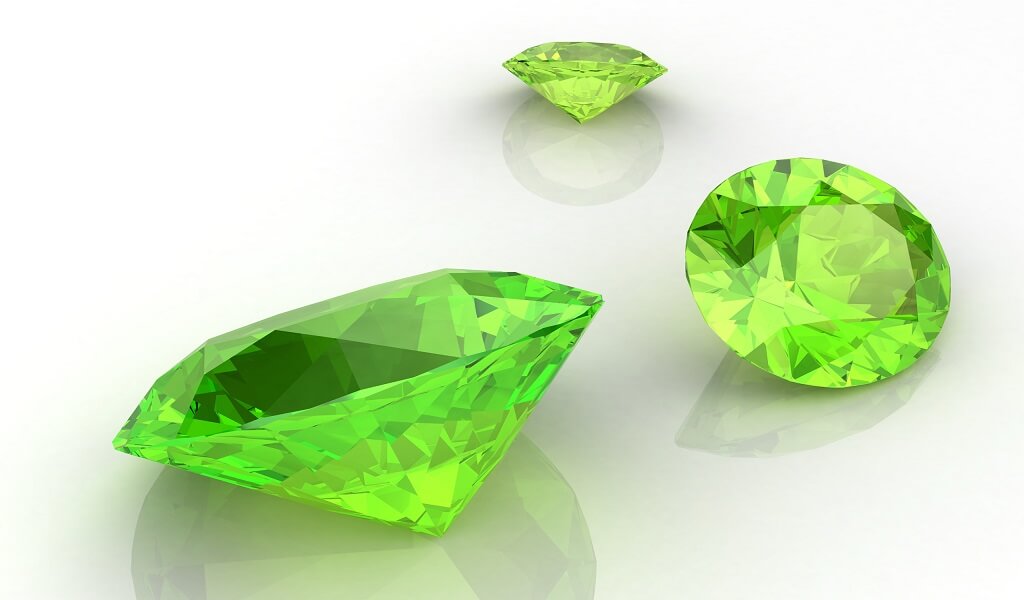
Peridot has fallen in and out of fashion over the centuries but is now much appreciated for its unique healing and metaphysical properties.
Some Peridot is the result of a meteor landing on Earth and this extra-terrestrial aspect to the stone lends it a mystical, spiritual quality.
Physical Healing Properties
This wonderfully bright and cheerful stone has a tonic effect on both the mind and body.
It is both healing and regenerative for the tissues and muscles.
It stimulates and strengthens metabolism and has a beneficial effect on the skin.
Peridot is believed to have a balancing and regulatory effect on the hormonal and endocrine systems and is beneficial for eye conditions.
Peridot supports the kidneys and adrenal glands, livening up the entire system and making the physical body stronger and more vital.
It is good for the digestive system and aids in assimilating nutrients and minerals from food, water, and light.
Peridot is said to be beneficial for the liver, gall bladder, thymus, pancreas, and spleen.
The energy of Peridot is vibrant and full of life, associated with the element of wood, renewal, and rebirth.
It is said that placing Peridot on the abdomen during childbirth imparts strength and lessens the pain of contractions.
Mental & Emotional Healing Properties
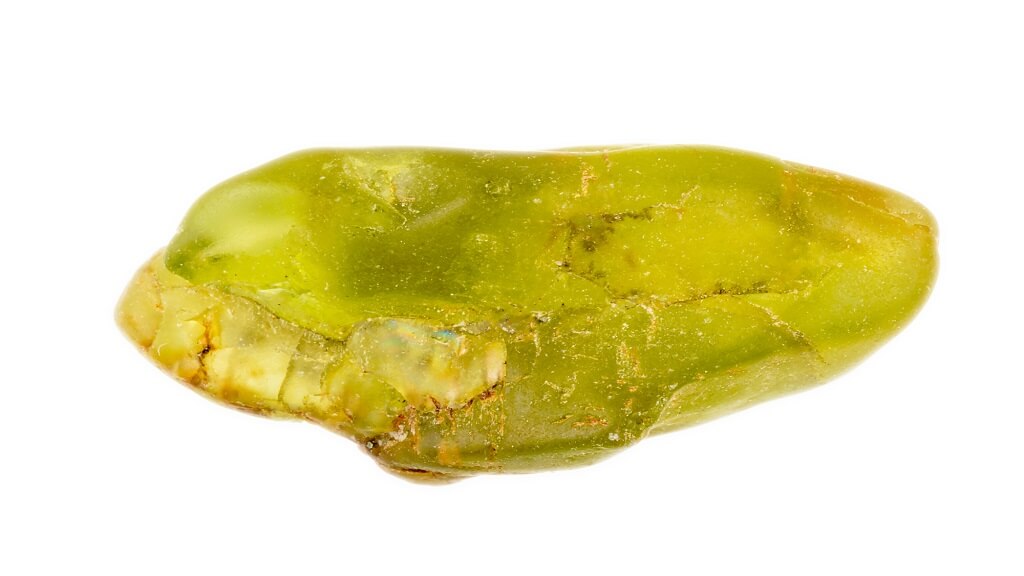
Peridot sharpens the mind and brings clarity to muddled thinking.
It is also said to open the mind and emotions to the possibility of new ways of thinking and being.
It promotes deeper levels of self-awareness and encourages us to see, and admit to, our mistakes and to learn from them in order to do better next time.
Peridot encourages us to take full responsibility for our own lives and to take back our power when we have allowed others to control or manipulate our feelings.
The influence of Peridot can be invaluable in “difficult” relationships, especially when one partner has domineering or even aggressive tendencies.
Peridot is an excellent crystal for supporting the Heart chakra and resolving emotional conflict.
It banishes feelings of betrayal, anger, hurt, and resentment, cleansing away ego driven feelings and bringing in compassion and understanding.
Peridot teaches us the value of letting go of old hurts and resentments from the past that are getting in the way of our achieving happiness in the present.
It is an excellent stone for forgiveness, both of the self and others, healing emotions and promoting self-esteem and self-worth.
Metaphysical Properties
Peridot is a stone with strong associations with the sun, light, and the truth.
It releases old patterns of negativity from the aura and transmutes negative vibrations so that a new frequency can be accessed.
It enables you to move forward rapidly, once you have done the psychological work necessary, and set firm intentions to change your situation.
It is a visionary crystal that helps you understand your destiny and purpose on the Earthly plane.
One of the main metaphysical properties of Peridot is its ability to help you to attune to all of the natural cycles and rhythms of your life on Earth.
We have circadian rhythms, menstrual cycles, diurnal rhythms, and seasonal changes throughout our lives. Some people find change disturbing or threatening.
Peridot helps us to accept that change is both inevitable and positive.
Peridot is especially helpful for breaking old patterns.
If you find that you keep repeating destructive behaviors, or constantly revisiting old emotional hurts, Peridot can help you to let go of that cycle and establish a new, healthier rhythm to both your physical and emotional lives.
Peridot can help to break cycles of addiction to substances and dependencies on people, things, or thought patterns.
This stone is said to aid us in finding what we have lost, whether this is a physical object or an emotional or spiritual state.
Spiritual Healing Properties
Spiritually, Peridot can help you on your journey to enlightenment and contentment.
It helps you to trust your intuition and to look inward for guidance rather than relying on outside influences.
With Peridot you can begin to access the wisdom of the Higher Mind.
It is a stone of independence and brings reassurance that your faith, beliefs, and principles are as valid as the next person’s.
In spiritual development work, Peridot allows us to accept the world as it is, without illusions or denial.
And then to transform those aspects that we do not wish to keep into a new, more positive, and rewarding experience.
Peridot is attuned to spiritual truth and to the understanding of our own destiny.
It is not a crystal for escaping the reality of the material world, as some stones do, but for aligning our own truths, spiritual beliefs, and principles with our physical reality.
How to Use Peridot

As Jewelry
Peridot worn as jewelry is both attractive and uplifting.
The bright green sparkles of the stone remind you of the beauty that is to be found in nature all around you.
Its energy of optimism and vitality can lift the darkest of moods.
So even if you don’t wear it you can place a piece of this gorgeous green crystal in your pocket or purse to handle and look at during the day.
In-Home and Office
Peridot is a good stone of protection against ill wishes, curses, and the bad attitudes of others.
If you have Peridot near your workspace, you can access its powers to enhance your creativity and help with problem solving.
Best Crystal and Gemstone Combinations with Peridot
From a purely aesthetic point of view, the combination of Peridot with Pave Diamonds in a setting of gold or rose gold is hard to beat.
Diamonds enhance the naturally vibrant sparkle and glint of a well-cut Peridot, and the gold complements any yellow hues that may be present in the Peridot stone.
When working on opening, activating, and protecting the Heart Chakra, Peridot can be paired with Rose Quartz.
This combination is ideal as the Heart chakra is aligned to both pink and green hues.
You can combine Citrine with Peridot for an extra boost of physical and emotional energy, or with Amethyst to promote your spiritual development.
Final Thoughts & Conclusion
Peridot is warming and soothing. It carries the energy and warmth of the sun within its depths and brings in vibrations of hope, life, and renewal.
It works with the energy of Wood in Feng shui making it a great nurturer and bringer of new life.
New projects and ideas are engendered with Peridot, and your own energy levels can receive a boost from this stone.
Peridot is a stone for healers, especially those who work with animals and in healing the planet.
The gorgeous, glittering facets of cut gems bring to mind the play of sunlight through the leaves of trees in Springtime.
Lifting your mood and promoting an appreciation of the simple joys of living. Gratitude abounds when Peridot is nearby.
References
Diamonds Pro | Geology | GIA

